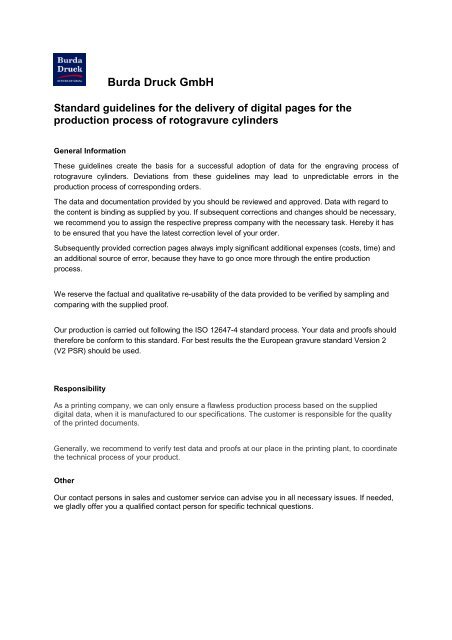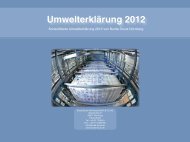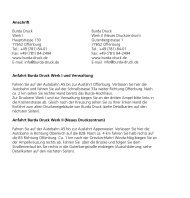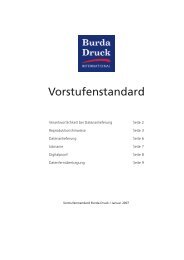Burda Druck Gmbh
Burda Druck Gmbh
Burda Druck Gmbh
You also want an ePaper? Increase the reach of your titles
YUMPU automatically turns print PDFs into web optimized ePapers that Google loves.
<strong>Burda</strong> <strong>Druck</strong> GmbH<br />
Standard guidelines for the delivery of digital pages for the<br />
production process of rotogravure cylinders<br />
General Information<br />
These guidelines create the basis for a successful adoption of data for the engraving process of<br />
rotogravure cylinders. Deviations from these guidelines may lead to unpredictable errors in the<br />
production process of corresponding orders.<br />
The data and documentation provided by you should be reviewed and approved. Data with regard to<br />
the content is binding as supplied by you. If subsequent corrections and changes should be necessary,<br />
we recommend you to assign the respective prepress company with the necessary task. Hereby it has<br />
to be ensured that you have the latest correction level of your order.<br />
Subsequently provided correction pages always imply significant additional expenses (costs, time) and<br />
an additional source of error, because they have to go once more through the entire production<br />
process.<br />
We reserve the factual and qualitative re-usability of the data provided to be verified by sampling and<br />
comparing with the supplied proof.<br />
Our production is carried out following the ISO 12647-4 standard process. Your data and proofs should<br />
therefore be conform to this standard. For best results the the European gravure standard Version 2<br />
(V2 PSR) should be used.<br />
Responsibility<br />
As a printing company, we can only ensure a flawless production process based on the supplied<br />
digital data, when it is manufactured to our specifications. The customer is responsible for the quality<br />
of the printed documents.<br />
Generally, we recommend to verify test data and proofs at our place in the printing plant, to coordinate<br />
the technical process of your product.<br />
Other<br />
Our contact persons in sales and customer service can advise you in all necessary issues. If needed,<br />
we gladly offer you a qualified contact person for specific technical questions.
Content of the guidelines<br />
1 Prepress notes<br />
1.1 Technical conditions<br />
1.2 Page structure<br />
1.3 General conditions for the proff production<br />
2 Delivery of data and printing documents<br />
2.1 Data formats and data delivery<br />
2.2 File naming / name convention<br />
2.3 Control of documents<br />
Contact<br />
Rolf Arnold<br />
<strong>Burda</strong> <strong>Druck</strong> GmbH<br />
Analysis and assurance of production processes<br />
Hauptstraße 130<br />
D-77652 Offenburg<br />
Phone +49 (7 81) / 84-28 65 - Fax +49 (7 81) 7 61 77<br />
www.burda-druck.de<br />
e-mail rolf.arnold@ burda.com
1 Prepress notes<br />
Following specifications apply to the delivery of the final pages. We cannot ensure proper<br />
implementation of your templates if our requirements are not met.<br />
1.1 Technical Conditions<br />
General<br />
Your data must be created in CMYK color process.<br />
Special colors and RGB / Lab defined data will not be processed. If RGB data is included in<br />
your data, and we have to meet a schedule, we do not accept any liability for implementing the<br />
color of your product.<br />
Image Data<br />
The maximum coverage is 340%. Color profiles have to be coordinated with the printing<br />
company.<br />
> An achromatic structure, e.g. UCR and GCR should be avoided. This would lead to<br />
different printing results than indicated in the proof.<br />
> The first printing tone values are about 5% tonal value. Printable elements should therefore<br />
have 5% in each color channel. Technical tones and fonts should have at least 7% for each<br />
color channel.<br />
Text<br />
> Black text should be created only in 100% black and overprint.<br />
> With changing versions (such as language change in black) elements may only be changed<br />
in the varying color.<br />
> The selection of fonts must be adapted to the rotogravure process:<br />
> Positive text at least 0.20 mm line width<br />
> Negative texts at least 0.25 mm line width
1.2 Page Structure<br />
> The data can be delivered as a single or a double page.<br />
> All pages must have a all around square trim<br />
> All pages of an order must have the same geometric dimensions.<br />
> All pages must be centered in the document.<br />
> Trim-Box = net format<br />
> Bleed Box = trim (gross format) We recommend a consistant trim of at least 4 mm on<br />
each side<br />
> Crop box and media box should match the format, and ideally also the<br />
gross format.<br />
Crop marks are to be created in CMYK 2.5 mm outside of the cropped format<br />
Please note that important visual elements (text, logo) are placed in a distance of at least 5<br />
mm from the outer trim.<br />
Text elements breaching the collar should be moved apart in the collar depending on the type<br />
of subsequent processing type
1.3 General conditions for the proof production<br />
The digital quality proof is the central means of control in the processing of print jobs. Only<br />
by using calibrated proofers (Delta E File name<br />
> Proofer type<br />
> Proof parameters with checksum<br />
> Date and time of production of proofs and last calibration<br />
> Media wedge (FOGRA)<br />
Proof assessment<br />
The assessment of the proof is carried out under standard light<br />
> Light type 5000 Kelvin<br />
> Overview 2000 Lux<br />
The proofs must be checked by the supplier by verification of the media wedge and<br />
documented by means of a sticker or imprint. Tolerance requirements are those of the ISO<br />
12647-7.<br />
Object proof<br />
The object proof is used for the verification of completeness and is not binding regarding color.
2 Delivery of data and printing documents<br />
The client provides imprimated (print free) final pages to the printing plant. For reasons of<br />
data security no open data formats (such as QuarkXPress, Illustrator, InDesign, etc.) are<br />
processed.<br />
Please note:<br />
Subsequently provided page correction proofs create additional work. These pages have to<br />
run again through the whole process, including test routines.<br />
The labelling of the printing documents and file names must be clearly and well defined.<br />
Data is delivered via FTP servers. Login data is provided by the customer service center.<br />
Digital bill of delivery<br />
A “readme file” has to be attached to each delivery as a digital bill of delivery with the<br />
following specifications:<br />
> Sender<br />
> Contact person (with contact information such as phone, e-mail)<br />
> Order and sheet specification<br />
> Color space / process standards with which the data were created
2.1 Data formats und Data delivery<br />
■ Data format Tiff/s all in PDF/X-4 2007-2010<br />
in Version 1.4-1.5<br />
PDF/X-1a2003 in<br />
Version 1.4<br />
Tiff IT P1 CT+LW<br />
Job components 1 job component 1 job component 1 job component 2 job components<br />
CT+ LW<br />
Comment All page elements<br />
calculated to one<br />
final page as picture<br />
anti-aliasing<br />
Reference PDF * Adobe Distiller,<br />
Adjustment <strong>Burda</strong> <strong>Druck</strong>.<br />
Version PDF 1.4-1.5, all fonts<br />
have to be embedded. Black<br />
fonts have to be overprinting.<br />
Embedded IC profiles will not<br />
be processed<br />
Resolution<br />
Picture<br />
Color<br />
Text<br />
300 DPI 120L/cm 300 DPI 120L/cm<br />
900 DPI 360L/cm<br />
900 DPI 360L/cm<br />
Other One PDF per page (no piled PDFs)<br />
Data Carrier According to agreement<br />
Adobe Distiller, Adjustment<br />
<strong>Burda</strong> <strong>Druck</strong>. Verion PDF 1.4-<br />
1.5, all fonts have to be<br />
embedded. Black fonts have to<br />
be overprinting. Embedded IC<br />
profiles will not be processed<br />
300 DPI 120L/cm<br />
900 DPI 360L/cm<br />
900 DPI 360L/cm<br />
Directories Data is to be sorted logically into subdirectories (e.g. Language switch).<br />
Jobname<br />
according to<br />
glossary<br />
CT and LW have<br />
to show the same<br />
geometric<br />
measures<br />
300 DPI 120L/cm<br />
900 DPI 360L/cm<br />
900 DPI 360L/cm<br />
Compression Only compression<br />
processes without any data<br />
loss are allowed (e.g.<br />
ZIP,LZW)<br />
Data security For reasons of process and data security no deliveries via email or downloading from internet servers are possible. In<br />
case of impossibility for a FTP transfer an exceptional transfer service is possible. The hereby occurred expenses<br />
(cost/time), are depending on the transfer speed und the additional data handling.
2.2 File Naming / Name Convention<br />
Below mentioned are examples of a possible regulation of the nomenclature between the<br />
customer and <strong>Burda</strong> <strong>Druck</strong> GmbH. The examples represent the ideal solution for efficient and<br />
automated data processing. Please note that once agreed name conventions between the<br />
customer and <strong>Burda</strong> <strong>Druck</strong> GmbH must be strictly observed.<br />
Examples for All-in Data:<br />
Customer | Issue | page number | Language variant | Revision<br />
Klingel KLKN12_002003DE_A.pdf<br />
KLKN12_002003DE_B.pdf (Correction page)<br />
KLKN12_002003NL_A.pdf (Language switch)<br />
Standard for the country code is the international standard for country codes<br />
ISO 3166<br />
Outiror OR155_0012A1_A.pdf<br />
OR155_0012A1_B.pdf (Correction page)<br />
Example of the separate delivery of text and image components:<br />
Revision<br />
Text / Bild (Picture) | Customer | Issue |page number | language variant |<br />
Klingel Bild_KLKN12_002003DE_A.pdf<br />
Text_KLKN12_002003DE_A.pdf<br />
2.3 Control of Documents<br />
Correction and language switch, see the example above.<br />
To each page and version release a correction-free color proof of the page, respectively in the<br />
case of changes, a binding object proof has to be delivered.<br />
Proofs must be created from the data supplied to the printing plant.<br />
In case of missing documentation at the state of approval for engraving, only the delivered data<br />
will be taken as reference.<br />
In case of differences between data and proof the delivered data is binding.






